Florida Trees and Shrubs
On this page - Paradisetree, Marlberry, Carolina Willow, Strangler Fig, American Persimmon, Gulf Greytwig, Devil's walking-stick, Red Mulberry, Javanese Bishopwood, Chinese Tallow Tree, Hawaiian half-flower,
Paradisetree - Simarouba glauca
Family - Simaroubaceae
Native
_small.jpg)
_small.jpg)
Tree - generally with a single, straight trunk up to 50 feet tall with a 30 foot spread. Leaves are stiff, alternately arranged on the branch, even-pinnately compound and can be up to 16 inches long with 10 to 14 elliptic to oval leaflets that are dark shiny green above, and a lighter greyish-green underneath, individual leaflets may be up to 3 inches long. New growth is reddish-brown.
Flowers in eary spring with small yellow to cream colored blooms in profuse terminal and/or. axillary clusters. Fruit is a reddish oval drupe just under an inch long turning black when mature this tree is frost sensitive and grows near the coast in South Florida.
Marlberry - Ardisia escallonioides
Family - Myrsinaceae
Native
_small.jpg)
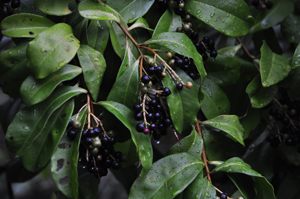
Habitat - Coastal Hammocks, Inland Hammocks, forms thickets
Description - Native shrub or small tree to 20 feet or more in south Florida, more commonly 12-15 feet. Narrow crown, taller than broad, slender trunk and branches with thin, pale grey bark. Leaves are a shiny dark green above, paler dull green below, elliptic, alternate, 4-8 inches long, margins entire.
Flower - Fragrant, creamy white throughout the year, produced in terminal clusters. Fruit is a fleshy drupe, 1/2 inch or less, deep red to black
Carolina Willow - Salix caroliniana
Family - Salicaceae
Native
_small.jpg)
_small.jpg)
_small.jpg)
_small.jpg)
Small tree or large shrub with a height of 15-30 feet, usually with multiple trunks found along freshwater river banks, ponds, lakes, ditches, marshes, shrub swamps in moist to wet soils.
Common throughout most of South Florida. Leaves are alternate, 2-7 inches long, lanceolate, with finely serrate margins. Small green and yellow flowers borne on 3-4 inch catkins are produced in early spring, bees are attracted to the pollen. Host plant for the Viceroy butterfly.
Strangler Fig - Ficus aurea
Family - Ficus
Native
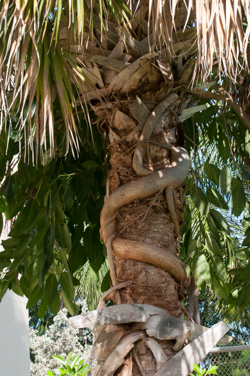
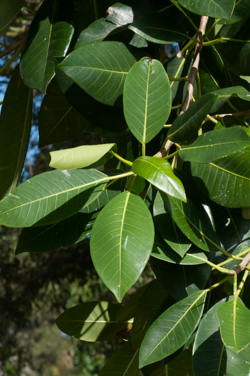
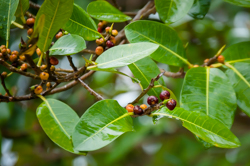
Found in hammocks, swamps, cracks and joints in bridges and other structures, anywhere a Sabal palm grows.Seedlings begin life as a epiphyte nestled in the frond boots of cabbage palms (Sabal palmetto) occasionally on other trees, and man-made structures. The strangler fig gets its name because its roots may eventually completely engulf and strangle the host tree, thus becoming a free standing tree. Strangler fig seeds will germinate and take root in almost any available crack in concrete.
Height to 75 feet with a broad, spreading crown and numerous aerial roots. Leaves are alternate, 6-8 inches long, dark green, elliptic to ovate in shape with entire, slightly undulate margins.
American Persimmon - Diospyros virginiana
Family - Ebenaceae
Native
_small.jpg)
_small.jpg)
_small.jpg)
Found in a variety of habitats from the wet soils of mixed bottomland forests and swamps to dry uplands throughout Florida.
Large tree with a trunk up to 24 inches in diameter growing to 70 feet tall. Leaves are alternate, ovate to elliptical, shiny green above and light green below, young leaves are pubescent underneath, older leaves often have black spots on upper surface, turning yellow to orange in fall.
Flowers are bell shaped, creamy white in color. Persimmon blooms in spring, flowers are followed by round to slightly flattened berry type of fruit, 1 - 3 inches across that is a reddish-orange color when mature, fruit contains 5 to 8 flat seeds.
Gulf Greytwig - Schoepfia chrysophylloides
Family - Olacaceae
Native

Habitat - Hammocks, Shell mounds
Description - Endangered. Small Florida native tree or a large shrub, endemic to Florida within the U.S.. To 20 feet tall with an equal spread. Graytwig leaves are somewhat thin, elliptic with entire margins, alternate arrangement, drab green on upper surface and lighter green on undersides. Small red to orange flowers produced from leaf axils year-round in S. Florida, with peak flowering in spring and fall.
Devil's walking-stick - Aralia spinosa
Family - Araliaceae
Native


Native. Aralia spinosa shares common names with Zanthoxylum clava-herculis, another native armed with spines on the trunk and branches. Devil's walking-stick grows as a deciduous shrub or small tree and can reach heights of 35 feet under ideal conditions.
This plant is usually found in coastal areas that have been disturbed by human activity or in clearings created by fire, as it is intolerant of shade. Small white flowers are produced in large clusters at the branch tips in summer, are quite showy and very attractive to honey bees.
The small berries are purple to black when mature and although readily consumed by birds and other wildlife, are mildly toxic to humans. Leaves are large, bipinnately compound and even these are armed with sharp prickles.
Red Mulberry - Morus rubra
Family - Moraceae
Native

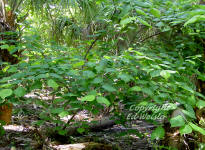
Habitat - Hammocks, Bottomland Forests, Upland Forests, Floodplains, Flatwoods.
Native shrub or tree to 65 feet, typically with a low branching habit, irregular grey-brown bark sometimes orange tinged in young trees, bark becoming ridged in older trees.
Leaf form is variable, alternate, simple, margins serrate, may be un-lobed or deeply lobed, green above with a rough, scabrous texture, paler green and fuzzy on lower surface.
Flower - Pale green hanging catkins, 1-2 inches long. Fruit is a cylindrical, cluster of black drupes to 1 1/4 inch long, resembling blackberries.
Javanese Bishopwood, Toog tree - Bischofia javanica
Family - Euphorbiaceae
Exotic / Invasive



Habitat - Disturbed wetland sites, Cypress domes, Hardwood hammocks
Category I invasive tree introduced from Asia as an ornamental landscape tree, it is now invading natural areas in South Florida where it alters/displaces native plant communities. Seeds are dispersed by birds that eat the fruit.
Height to 60 feet, leaves are on long petioles (stems), are compound with 3 leaflets & toothed margins, often with a bronze hue. Thrives in moist soil, flowers are in racemes at leaf axils, fruit is a small round brown/reddish brown to dark blue berry less than a 1/2'' in diameter, produced in large clusters. Sap is milky, as is typical of the Euphorbiaceae family.
Chinese Tallow Tree - Sapium sebiferum
Family - Euphorbiaceae
Exotic / Invasive
%20_small.jpg)

Category 1 invasive tree, a fast growing deciduous perennial tree, 30 to 50 feet. Widely used in landscaping. Leaves are alternate with entire margins, broadly ovate with acuminate apices.
Commonly found in wet areas - low lying forests, freshwater swamps margins of rivers, lakes, ponds, creeks, and ditch banks. Can be found drier upland habitats as well.
Flower - Small yellow flowers on spikes to near 8 inches long. Fruit is a waxy three lobed capsule 1/2 inch in diameter.
Beach naupaka, Hawaiian half-flower - Scaevola plumieri
Family - Goodeniaceae
Exotic / Invasive

Category 1 invasive plant. Large, bushy shrub to 16 ft. tall, commonly forming dense mounds. Flowers are white to pale lilac in short clusters at leaf axils, fruit is a green fleshy drupe.
Common to dunes, coastal hammocks and estuary shorelines. Once promoted for use in beach stabilization projects, now displaces native species.
Tropical Soda Apple - Solanum viarum
Family - Solanaceae (Nightshade)
Exotic / Invasive

Category 1 invasive plant species, listed as a noxious weed in Florida. Perennial shrub native to Brazil and Argentina, growing to 6 feet in height, it is more common at 3 ft. or less. First discovered in Florida in 1988 it has since spread to over 500,000 acres statewide. Identified by numerous straight thorns on stems and leaves and its distinctive fruit.
Fruit is a globose berry, 0.8-1.2 inch wide, green with darker veins like a miniature watermelon, a dull yellow at maturity and poisonous to humans, also reported to cause miscarriages in cattle that consume it.
Each fruit contains hundreds of small flattish seeds and a single plants is capable of producing tens of thousands of seeds in a single season. Cattle, raccoons, deer and birds feed on the fruit and then disperse the undigested seeds.